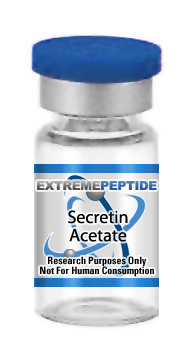(Click here to read our disclaimer)
Secretin acetate is a hormone that is made up of 120 amino acids which are a precursor to the prosecretin protein. It contains a spacer, N-terminal single peptide and secretin. Mature secretin peptides make up a linear hormone that has a molecular weight of 3055 with a helix formed from the amino acids at 13 and 5. These sequences are similar to vasoactive intestinal peptides, glucagon and gastric inhibitory peptide. Secretin may also amidate cerbodxyl- terminal amino acids in the body.
Secretin is synthesized by creasing cytoplasmic secretory granules of the S cells commonly found in the duodenum’s mucosa as well as the jujunum in the small intestine. These can be released into circulation within an animal to respond to low duodenal pH, about 2 to 4.5 depending on the type of animal that is being studied.
The hormone will target the pancreas causing it to release a bicarbonate fluid into the intestine that will neutralize excess acid so these tissues will not be burned.
Plasma Secretin as a Pancreatic Response
Dogs with gastric duodenal Thomas cannulas were investigated to determine the dose range that exogenous secretion for pancreatic bicarbonate secretion and an increase in plasma secretin concentrations would occur.
- Synthetic secretions of this chemical were dissolved in a saline solution and applied to the dogs without a background infusion.
- Minimal doses of secretin acetate were found to elicit a pancreatic bicarbonate response that was somewhat significant in addition to an increase in concentrations of plasma secretions.
Postpradinal secretion concentrations were measured and found that a meal consisting of meat would cause a larger spike in secretin acetate than spikes occurring during the infusion. Secretin and intraduodenal acid profusion would increase in larger doses but were unchanged by the concentrations added by a background caerulein infusion.
Synthesis of Gastrointestinal Peptides with Secretin
The REMA method was found ideal for creating a synthesis of secretin in animals that would be suitable for experimentation.
- This procedure is quite rapid because it is on a small scale and creates a synthesis of one amino acid each day to be attained and may yield an unambiguous product.
- After an ion-exchange chromoatography the REMA secretions were found to be chemically identical to the secretin acetate fragments that would be produced by an animal’s body.
These synthesized hormones showed similar biological activity to clinical units that are regularly compared to natural versions of this hormone. The yield of secretin acetate also produced a hepacosapeptide amide that was calculated to be the basis of a C-terminal residue. This made up approximately 5 percent of the final product.
Additional factors that may impact secretin release include the presence of fatty acids or bile salts which will act as‘bicarbonate’ when they reach the small intestine. This chemical is also inhibited by H2 antagonists which help the body to reduce gastric acid secretion as necessary. This results in any secretions of the duodenum above 4.5, being unaffected by secretin so it will not be released under these conditions.
Sources:
http://onlinelibrary.wiley.com/doi/10.1002/hlca.19760590415/abstract
http://ajpgi.physiology.org/content/246/5/G535.short
Click here to view our entire PDF research library
Click here to view/download the PDF version of this article
